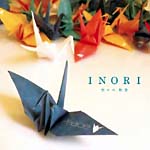"INORI" by Yuji Sasaki

|
I knew I would have to go, but I couldn't say what I really felt (Original Japanese lyrics by GOD BREATH )
|
Putting Sadako's thoughts into song
Cherishing the lives of others, too

|
Yuji Sasaki
Born in 1970 in the city of Fukuoka. He started singing in a band when he was in junior high school. After graduating from Fukuoka Foreign Language College, he began working in Tokyo. He formed a rock band called GOD BREATH with childhood friends. Since 2009 he has pursued a career as a solo artist. With his father, he founded the NPO "SADAKO LEGACY" and is engaged in activities to promote peace.
Sadako Sasaki was two years old when the atomic bomb was dropped on Hiroshima. Ten years later she abruptly developed leukemia, an effect of the bomb's radiation. While in the hospital, she prayed to get well again, and believed that folding a thousand paper cranes would restore her health, but she passed away at the age of 12. Sadako was the inspiration for the Children's Peace Monument in Hiroshima Peace Memorial Park.
Yuji Sasaki, 40, Sadako's nephew, shared how he came to write his song: "Despite facing death, Sadako always showed a brave smile to her family. I tried putting myself in her place to compose the lyrics."
When Yuji was a child, he attended the Peace Memorial Ceremony every August 6 with his father Masahiro, 69, Sadako's elder brother. However, looking back, he says, "I didn't feel as if it had anything to do with me."
The turning point came about a decade ago. Yuji was in Tokyo, where he played in a rock band, and his father was paying a visit to the city to deliver a lecture. At the lecture venue, some high school students and teachers told him: "You have Sadako's DNA. As a musician, you should sing a song about Sadako." "That was a shock to me," Yuji recalled. Their words made him feel closer to his aunt, and he started composing the song.
Since he was a young boy, Yuji has heard about Sadako from his father and his grandfather Shigeo. He was particularly surprised to hear that Sadako's family didn't tell her the name of her illness, but after her death, they found a note in which she had copied the counts of her white blood cells and red blood cells, derived from an examination. "Sadako didn't put up any complaints, though she realized she had leukemia," Yuji explained. "But it wasn't possible for her to endure alone. She must have wanted someone to lean on." In this connection, he used the repeated phrase "I cried and cried, I was tried of crying."
In the beginning, he used the melody of a popular Mongolian song about Sadako. However, last year when he struck out on his own as a solo performer, he composed a new, hopeful melody for his lyrics.
He also speaks about Sadako at mainly elementary schools and junior high schools. Over the past ten years, he has visited more than 300 schools. He describes Sadako's life, her experience of the atomic bombing and her time in the hospital, and plays his guitar. He appeals to the students: "Sadako wasn't able to live out her life. I hope all of you will appreciate your lives and cherish the lives of the people around you." He also shows them a small paper crane that Sadako folded.
In addition to this small crane, he has three more paper cranes that Sadako herself folded. Originally, he had six of her cranes, but he sent one to the Tribute WTC Visitor Center in New York which commemorates the terrorist attacks of September 11 and another to a peace museum in Vienna. He has plans to present these three other cranes to places in Brazil, Africa, and Hawaii. "Both the victims and the perpetrators were harmed by the bombing," he said. "I hope sharing Sadako's cranes can help put an end to war in people's hearts." (Rie Nii, Staff Writer)
|